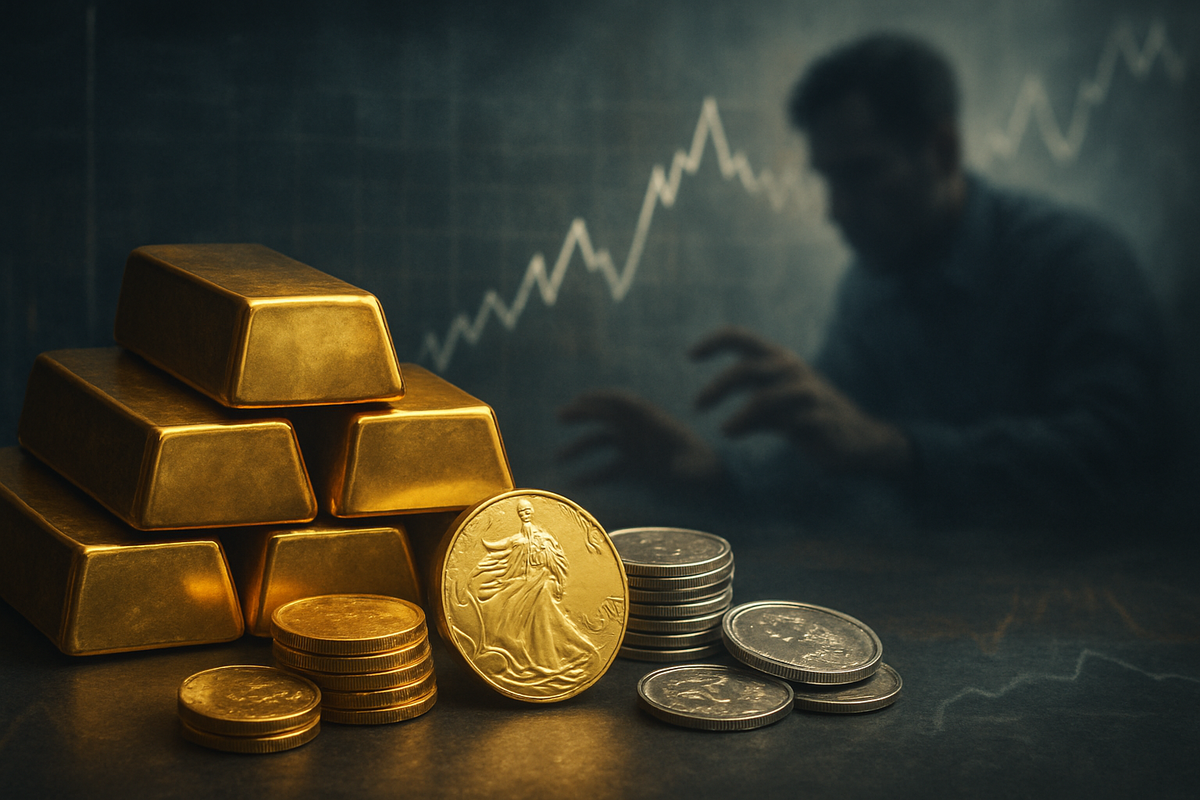
As of October 21, 2025, persistent and escalating inflation concerns have propelled gold and silver prices to unprecedented levels, fundamentally reshaping investor behavior and the broader financial landscape. Both precious metals have shattered previous records, reaching astonishing highs before experiencing sharp, albeit potentially temporary, corrections. This dramatic rally underscores their enduring role as traditional safe-haven assets amidst a backdrop of economic uncertainty, anticipated Federal Reserve rate cuts, and simmering geopolitical tensions, forcing investors to recalibrate portfolios and seek tangible stores of value.
The current inflationary environment remains the paramount concern for global investors, consistently ranking as a top worry throughout 2025. Headline inflation, as measured by the Consumer Price Index (CPI), has shown an upward trend, reaching 2.7% year-over-year in July and projected to accelerate further to 3.1% annually by October 2025. This renewed inflationary pressure is casting a significant shadow over global stock markets, prompting a widespread flight to safety and a strategic rebalancing towards precious metals.
The Gold Rush of 2025: A Detailed Account of Unprecedented Volatility
The period between late 2024 and October 2025 has been a wild ride for precious metals, characterized by historic surges and subsequent sharp corrections. Gold (XAU) broke through the $4,000 per ounce milestone earlier in October 2025 and reached an all-time nominal high of approximately $4,398.00 per ounce on October 20, 2025. Similarly, silver (XAG) achieved its own all-time high, touching $54.3775 per ounce in mid-October 2025, marking an almost 80% year-to-date gain and its strongest rally since 2011.
However, the dramatic ascent was swiftly followed by significant pullbacks. As of October 21, 2025, gold fell to $4,114.87 USD per troy ounce, down 5.57% from its peak, while silver dropped more than 5% to $48.44 USD per troy ounce, down 7.43% from its high. These corrections are largely attributed to widespread profit-taking after hitting record valuations, a temporary strengthening of the US dollar, and an easing of safe-haven demand amidst improving global sentiment, particularly regarding US-China trade tensions. Despite this short-term volatility, dip buyers quickly emerged, signaling continued underlying investor confidence.
Several fundamental drivers underpin this historic rally. Persistent inflation concerns, alongside rising sovereign debt levels and fears of currency debasement, have driven investors towards gold and silver as reliable stores of value. Expectations of impending Federal Reserve rate cuts, with a quarter-point reduction anticipated in October 2025 and at least one "jumbo" cut by year-end, have made non-yielding assets like gold and silver more attractive. Heightened geopolitical risks, a weakening U.S. dollar (down 9.4% year-to-date as of October 16, 2025), and unprecedented central bank demand—with 95% of central banks expecting to increase gold reserves—further fuel the bullish sentiment. For silver, robust industrial demand from the burgeoning green energy sector (solar photovoltaic, electric vehicles) has created a structural supply deficit, contributing significantly to its price appreciation.
Key players driving this market include central banks, which accumulated over 1,000 tonnes of gold annually in both 2023 and 2024, marking consecutive record years of sovereign gold demand. Major institutional investors are also dramatically rebalancing portfolios, with some, like Morgan Stanley, recommending a revolutionary 20% allocation to gold. Retail investors, particularly in Asia, are showing strong demand for physical bullion. Mining companies, refiners, and industrial users (especially for silver) are also critical stakeholders, each experiencing unique pressures and opportunities from the volatile market.
Corporate Fortunes: Winners and Losers in the Precious Metals Boom
The unprecedented surge and subsequent corrections in gold and silver prices have created a bifurcated landscape for public companies across the precious metals ecosystem. While high prices generally boost profitability, volatility demands strategic adaptation.
Potential Winners:
Low-cost gold and silver miners with robust balance sheets are poised to maximize profitability. Companies like Barrick Gold Corporation (NYSE: GOLD) / (TSX: ABX) and Newmont Corporation (NYSE: NEM) benefit from their scale, operational efficiency, and premium asset bases, allowing them to expand profit margins significantly as metal prices outpace relatively stable production costs. Alamos Gold (NYSE: AGI) has also demonstrated significant operating leverage, translating rising gold prices into substantial increases in earnings and cash flow. Royalty and streaming companies such as Wheaton Precious Metals Corp. (NYSE: WPM) are particularly well-positioned, benefiting from rising metal values without incurring direct operational risks, often showing greater resilience during market corrections. Physically backed Exchange Traded Funds (ETFs) like SPDR Gold Shares (NYSEARCA: GLD) and iShares Silver Trust (NYSEARCA: SLV) directly reflect the appreciation of the underlying metals, attracting substantial inflows. In certain emerging markets, gold loan Non-Banking Financial Companies (NBFCs) like Muthoot Finance and Manappuram Finance thrive as higher gold prices increase the loanable value of pledged gold.
Potential Losers:
Conversely, high-cost producers and junior miners are highly vulnerable during price corrections. Their projects may quickly become uneconomical, leading to potential delays, cancellations, or even consolidation. Companies such as Pan American Silver Corp. (NASDAQ: PAAS), Hecla Mining Company (NYSE: HL), First Majestic Silver Corp. (NYSE: AG), Coeur Mining, Inc. (NYSE: CDE), and Endeavour Silver Corporation (NYSE: EXK) experienced declines of 6-8% during recent corrections, highlighting their sensitivity to price swings. Industries heavily reliant on precious metals as raw materials, such as jewelry manufacturers and electronics companies, face increased input costs during high-price environments, which can squeeze profit margins and dampen consumer demand. While corrections might offer temporary relief, extreme volatility makes planning difficult. Leveraged investment funds and ETFs tracking mining stocks, such as the VanEck Gold Miners ETF (NYSEARCA: GDX), while performing well in rallies, suffer disproportionately during downturns due to the inherent leverage of their underlying holdings.
Beyond the Bullion: Wider Implications for the Global Economy
The current surge in gold and silver prices, driven by inflation concerns, is not an isolated event but rather a symptom of deeper, transformative trends impacting the global economy. This phenomenon carries significant wider implications across various sectors.
Firstly, the de-dollarization trend is gaining undeniable momentum. Geopolitical shifts, economic uncertainties, and inflationary pressures are prompting numerous nations and central banks to reduce their reliance on the U.S. dollar as the primary reserve currency. The unprecedented gold accumulation by central banks, particularly in emerging markets, signifies a strategic diversification away from fiat currencies and a preparation for a potential international monetary reset. This sustained institutional demand provides a structural floor for gold prices and challenges the long-standing hegemony of the dollar.
Secondly, the energy transition is profoundly impacting silver. The global push for clean energy systems, including solar panels and electric vehicles (EVs), is creating an unprecedented demand for critical minerals and metals. Silver is an indispensable component in these technologies, with industrial consumption from the solar photovoltaic sector becoming a major structural growth engine. This robust industrial demand, coupled with constraints from declining ore grades and environmental regulations, contributes to a persistent supply deficit, supporting silver's price appreciation and highlighting its dual role as both a precious metal and a vital industrial commodity.
The ripple effects extend to other asset classes. The "risk-off" sentiment bolstering precious metals can lead to shifts in investor allocations away from traditional financial assets like government bonds and certain equities. A sustained rally in gold could divert funds from less secure fixed-income instruments. For industrial consumers of silver, such as renewable energy and EV manufacturers, the surging cost of silver as a critical input places immense pressure on their operations, potentially incentivizing research into alternative materials or driving innovation in more efficient usage.
Regulatory and policy implications are also emerging. The proposed inclusion of silver in the U.S. Critical Minerals List is a significant development. Reclassifying silver from a precious metal to a strategic industrial asset could unlock federal funding, streamline permitting for silver projects, potentially lead to official stockpiling, and expose silver to Section 232 of U.S. trade law, highlighting supply chain vulnerabilities. Central banks may also be prompted to reassess monetary policies if the flight to gold signals a loss of confidence in fiat currencies. Historically, periods of high inflation, such as the 1970s stagflation, the Great Depression, and the 2008-2011 financial crisis, have consistently seen gold and silver perform strongly, reaffirming their role as inflation hedges and safe havens during times of economic and geopolitical stress. The current rally, particularly from 2019 to 2025, with gold's 85% appreciation outpacing the U.S. CPI's 23% rise, strongly echoes these historical precedents.
Navigating the Future: What Lies Ahead for Gold and Silver
The future of gold and silver prices, while promising in the long term, is expected to be characterized by continued volatility in the short term, requiring strategic adaptation from both investors and companies.
In the short-term (late 2025 - early 2026), despite recent corrections, analysts anticipate gold could still see a near-term peak possibly between $4,400 and $4,600 before potentially correcting towards $3,500. Silver, after its dramatic run, is also likely to experience further profit-taking, with experts suggesting a 10-20% correction. This period of consolidation and potential pullbacks is viewed by many as a "healthy reset" within a broader bull market, offering strategic buying opportunities. Market triggers to watch include the US Federal Reserve’s stance on interest rates, dollar strength, geopolitical de-escalation, and industrial growth in China. Hot inflation data could hurt chances of anticipated December rate cuts, leading to further volatility.
The long-term outlook (2026-2030 and beyond) remains robustly bullish. Aggressive forecasts for gold range from $5,000 to $10,000 per ounce by 2030, with some even reaching $15,051. Silver is anticipated to see even more significant appreciation, potentially hitting $65 per ounce in 2026 and exceeding $100 to $200 or higher by 2030-2035, potentially outperforming gold due to stronger bullish signals and industrial demand. These long-term drivers include persistent geopolitical risks, sustained central bank gold accumulation, ongoing economic uncertainties, a weakening U.S. dollar, and the metals' enduring role as inflation hedges.
For investors, strategic pivots are crucial. Diversification with a 5-10% allocation to gold is often recommended. A cautious and disciplined approach, including dollar-cost averaging and "buying on dips," is essential given the volatility. Understanding the inflation-hedging properties of both metals is key, and investors can gain exposure through physical bullion, ETFs, futures, or mining stocks. Monitoring Federal Reserve policy, central bank gold purchases, geopolitical developments, and US dollar strength will be critical.
For companies, particularly in the mining sector, strategic adaptations involve efficiently increasing production or acquiring new reserves during periods of elevated prices. However, they must be prepared for swift impacts on profitability during corrections. Industrial users of silver will need to explore hedging strategies or invest in researching alternative materials to mitigate rising input costs. Emerging market opportunities include increased demand from growing middle classes and central bank accumulation, while challenges include heightened volatility and supply chain issues.
Potential scenarios range from continued volatility within a broad range, to an aggressive bull market if geopolitical tensions escalate or economic downturns deepen (a "stagflation" scenario would be particularly bullish). A rapid resolution of global conflicts and a robust economic recovery could lead to a more sustained correction. Some long-term forecasts even envision a "monetary reset," where gold could challenge the US dollar's dominance, signaling a fundamental change in the global monetary system.
The Enduring Luster: A Comprehensive Market Wrap-up
The gold and silver markets in 2024-2025 have delivered a powerful message: in an era of persistent inflation, geopolitical instability, and shifting monetary paradigms, precious metals are reasserting their role as indispensable safe havens and stores of value. The historic price surges, driven by inflation concerns, central bank demand, and industrial applications, underscore a profound re-evaluation of trust in global finance.
The key takeaways from this period are clear: inflation remains a formidable force propelling tangible assets, central banks are actively diversifying away from the U.S. dollar, and silver's critical role in the green energy transition is cementing its long-term demand. While short-term volatility and corrections are a natural consequence of such rapid appreciation, they are largely viewed as healthy recalibrations within a sustained bull market.
Moving forward, the market will likely continue its bullish trajectory, albeit with periodic price swings. The lasting impact of this period will be a reinforced understanding of gold and silver's critical role in portfolio resilience and wealth preservation. They are not merely speculative assets but fundamental hedges against systemic risks in an increasingly unpredictable world.
Investors should remain vigilant in the coming months, closely watching inflation data, central bank policy shifts (especially from the Federal Reserve), geopolitical developments, and the strength of the US dollar. For silver, specific attention to industrial demand trends, particularly in solar and EV sectors, will be crucial. Being prepared for profit-taking and embracing a "buy on dips" strategy will be key to navigating the dynamic landscape of the precious metals market. The enduring luster of gold and silver is set to shine brightly for the foreseeable future, making them essential components of a diversified investment strategy.
This content is intended for informational purposes only and is not financial advice





